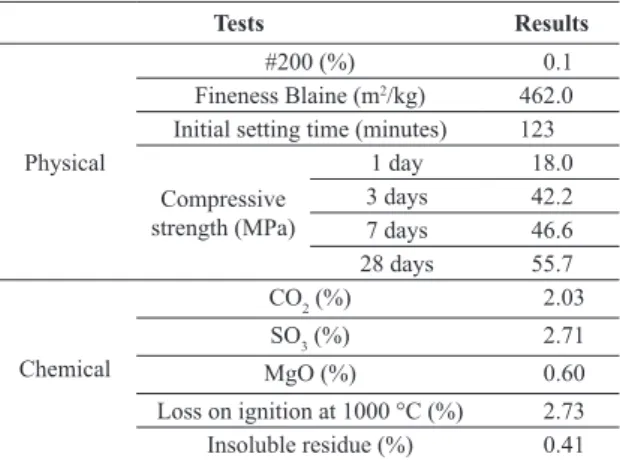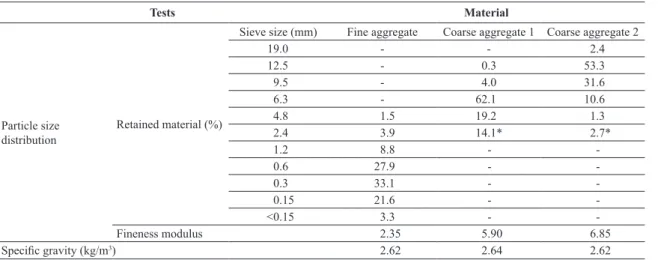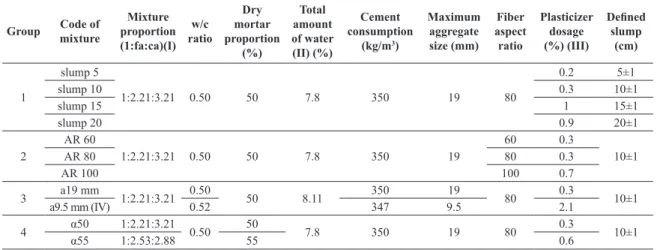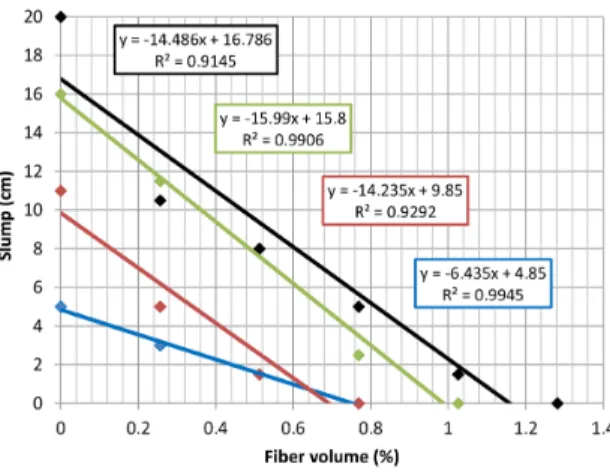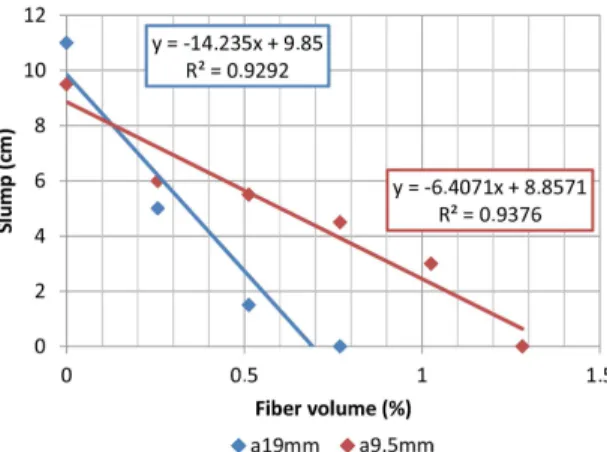*e-mail: antonio.igueiredo@usp.br
1. Introduction
The iber acts as a structural reinforcement for concrete, serving as a bridge for stress transfer in the cracks that may appear in the concrete matrix. Thus, the concrete brittle behavior is replaced by a non-brittle fracture related to a post-cracking bearing capacity1. So, the steel ibers are being increasingly employed in industrial loors, road pavements, and tunnel and channels linings, among other applications. One of the main reasons for this increasing use is the possibility of replacing entirely or partially the conventional reinforcement in structural applications2, which brings beneits such as labor saving and cracking control.
Despite various improvements in the mechanical properties of hardened concrete, the use of ibers reduces the luidity of the material3, which can cause negative impact in the workability of the concrete. The iber may cause dificulties for fresh concrete mixing, handling, placing and consolidation. One of the dificulties provided by ibers in mixing process is the iber ball production that generates lack of homogeneity and reduction in the iber reinforced concrete (FRC) performance4. During application, the iber could turn more dificult to cast the elements, demanding more labor time due to the lack of luidity. Also, the ibers could turn problematic to provide good inishing to FRC when they get concentrated on the surface. Coincidentally, the main aspects of the ibers that contribute most to the mechanical performance of the composite are those that bring dificulties to workability, which are the content and the aspect ratio (ratio between iber length and the diameter of the circle with area equal to the cross section of the iber). So, it is frequent to affect negatively the luidity of the material when the engineers are trying to improve the
hardened properties of concrete5. This fact occurs because the iber affects the relative mobility of coarse aggregate particles due to the dimensional compatibility between both. So, as higher is the volume and iber length as dificult became the relative movement between the coarse aggregates and the movement of the mixture in consequence. Also, there is a recommendation in order to use ibers with a length exceeding twice the maximum size of coarse aggregate aiming to enhancement the post-crack strength6. Therefore, the feasible iber consumption, in terms of applicability of the mixture, will be restrained by the amount of coarse aggregate7. A strategy to minimize this negative impact could be to increase the matrix mortar content, which corresponds to augment of the actual volume in which the iber is effectively incorporated. So, studies on the factors that obstruct the applicability of FRC are needed8.
In the international literature of the last decades, there are several studies that evaluate the inluence of the addition of ibers in the workability through traditional test methods5,9,10. However, these works had emphasized only the inluence of high content levels of steel iber (between 1% and 4% by volume). That condition is not the common situation for the majority of FRC applications in Brazil1. These high volumes of iber are applicable just when a strain-hardening behavior is requested for the composite2. So, there is a need in studies focusing lower content of ibers (up to 1% by volume) designate to applications where strain-softening or slight strain-hardening behavior is adequate as the FRC for pavements and tunnel linings.
The analysis of the impact of the ibers in the FRC workability was also addressed in some previous research focusing on self-compacting FRC11-13 or FRC with lightweight aggregate14,15. All these works were based on conventional
Workability Analysis of Steel Fiber Reinforced Concrete Using Slump and Ve-Be Test
Antonio Domingues de Figueiredoa*, Marcos Roberto Ceccatob
aEscola Politécnica, Universidade de São Paulo – USP,
CP 61548, CEP 05508-900, São Paulo, SP, Brazil
bTrima Engenharia e Consultoria, Rua Jacob Bereck Steinberg, 446,
Jardim Chapadão, Campinas, SP, Brazil
Received: August 9, 2015; Revised: October 5, 2015
This works present an experimental study addressing the workability of iber reinforced concrete (FRC). Only conventional measurements, such as slump and Ve-Be test, were used to evaluate the effect of the iber content in the mixture. The iber content shows to be of great inluence in the concrete mobility reducing the slump and increasing exponentially the Ve-Be time. The ibers act as a barrier to coarse aggregates movement reducing the materials mobility. So, increasing the aggregate size or the iber aspect ratio the lowability of the material will be reduced. In order to reduce that effect, an increase in the mortar content and/or in the initial slump could provide better workability conditions. The results showed that the Ve-Be test is not applicable to concrete with plastic consistency. On the other hand, slump test could not be adequate for stiff concretes that will be consolidated by intense vibration.
evaluations to measure workability as the slump, slump-low and V-funnel tests, for example. Other researchers used rheometers to assess the FRC fresh behavior. The studies were limited to ultra-high strength concretes16 or mortars17 but, up to now, rheometers are not suitable to evaluate the effect of the maximum aggregate size in plastic and especially stiff consistency concretes. This dificulty is associate to the risk of locking the rheometers rackets by the aggregates with greater diameter during the test. However, these kinds of concretes are of interest for such applications as pavements.
Thus, it is necessary the appropriate evaluation the FRC workability concerning the consistency changes provoked by the iber addition. Thus, evaluating the available methods, two relevant test methods were identiied. These are the slump test18 and Ve-Be test19. Previous studies20 demonstrated that the inverted cone test21 is not adequate when one wants to evaluate the workability of FRC. This fact could explain the reason that the standard related to this test method was discontinued. So, it was disregarded in this work. On the other hand, the study conducted by Laskar22 indicates that the Ve-Be test could be useful for FRC, although the iber content was too reduced (1.5% by weight). Thus, this study aims to evaluate some of the basic parameters FRC with low iber content and plastic consistency using test methods available and compatible with this condition.
2. Metodology
The initial consistency of concrete (before the addition of the ibers), the maximum size of coarse aggregate, the dry mortar content, the aspect ratio and the iber content were selected as independent variables for this experimental study. The initial consistency of the material is important because it is the main control parameter for many FRC applications. Thus, this experimental program aims to parameterize the impact of iber in the slump, measure by the Brazilian standard method ABNT NBR NM 67: 199818. When the FRC reach a stiff consistency with the augment of iber content, the workability will be parameterized by the use of Ve-Be test19. To facilitate the study of these selected variables were organized in four groups, depending on the variable that was assessed. Table 1 shows the four groups of analysis and the independent variables values.
High early strength cement (CP V type according to the Brazilian standard ABNT NBR 5733-EB2:1991[23]) was used in the experimental program. The characteristics of this cement are presented in Table 2. The aggregates used were a river sand and two crushed granite tones with two different sizes. The characteristics of these aggregates are presented in Table 3. Two admixtures were also used in the experiment. The irst one was a water reducing and retardant that its the requirement of the Brazilian standard ABNT NBR 11768: 2011 (type PR[24]). The second one was a setting inhibitor admixture (Delvocrete). The use of this retardant admixture was due to the extra time provided before initial setting. So, there was enough time to manipulate the material without any loss of luidity provoked by the material hydration reactions. This admixture was dosed to inhibit the setting reactions for eight hours, given enough time to complete all procedures.
The three ibers selected for the study were of circular cross section and with hook ends corresponding to the type
Table 1. Mixture groups organized according to the independent
variables used in the study.
GRUP 1: Inluence of initial consistency
Variable Values
Initial consistency 5, 10, 15, 20 cm
Aspect ratio 80
Coarse aggregate diameter 19 mm
Dry mortar content in
weight (α) 50%
Fiber volume 0, 0.26, 0.51, 0.77, 1.03, 1.28% Fiber consumption 0, 20, 40, 60, 80, 100 kg/m3
GRUP 2: Inluence of iber aspect ratio26
Variable Values
Initial consistency 10 cm
Aspect ratio 60, 80, 100
Coarse aggregate diameter 19 mm
Dry mortar content in
weight (α) 50%
Fiber volume 0, 0.26, 0.51, 0.77, 1.03, 1.28% Equivalent iber
consumption 0, 20, 40, 60, 80, 100 kg/m
3
GRUP 3: Inluence of coarse aggregate maximum size
Variable Values
Initial consistency 10 cm
Aspect ratio 80
Coarse aggregate diameter 9.5 mm, 19 mm Dry mortar content in
weight (α) 50%
Fiber volume 0, 0.26, 0.51, 0.77, 1.03, 1.28% Equivalent iber
consumption 0, 20, 40, 60, 80, 100 kg/m
3
GRUP 4: Inluence of dry mortar content in the matrix
Variable Values
Initial consistency 10 cm
Aspect ratio 80
Coarse aggregate diameter 19 mm
Dry mortar content in
weight (α) 50% and 55%
Fiber volume 0, 0.26, 0.51, 0.77, 1.03, 1.28% Equivalent iber
consumption 0, 20, 40, 60, 80, 100 kg/m
3
Table 2. Chemical and physical characteristics of the cement used
in the study.
Tests Results
Physical
#200 (%) 0.1
Fineness Blaine (m2/kg) 462.0
Initial setting time (minutes) 123
Compressive strength (MPa)
1 day 18.0
3 days 42.2
7 days 46.6
28 days 55.7
Chemical
CO2 (%) 2.03
SO3 (%) 2.71
MgO (%) 0.60
Loss on ignition at 1000 °C (%) 2.73
A1 of the Brazilian standard25. All of the ibers had only one ixed length and the diameter varied from one to another. So, the ibers used have different aspect ratios depending on the variation of its diameter, as shown in Table 4.These ibers were provided collated as presented in Figure 1. This condition helps to avoid clusters and turn easier the dispersion in the mix1.
A regular mixer, with inclined axis and 150 liters in capacity, was used to mix the materials. The irst materials introduced in the mixer were the aggregates in the dry state together with 30% of water and mixed for 30 seconds. Then the cement was added together with the remaining water containing the admixtures (plasticizer and setting inhibitor). In the sequence, the mixer was restarted and the mixture procedure takes 3 minutes. The plasticizer content was adjusted to obtain a slump value for each speciied mix. The materials were storage in the laboratory previously to the mixture production that occurred in the laboratory room temperature of 23±2 °C.
All the mixtures were submitted to the slump and Ve-Be tests, primarily for the concretes without ibers. At this moment the initial slump was measured. Then the controlled amounts of ibers were successively added in the same mixtures in order to reach the different iber contents proposed for the study. The Ve-Be and slump test were repeated after every iber content increment. So, the same matrix mixture was considered for all evaluations of the consistency inluenced by the iber amount.
Table 5 shows the composition and some characteristics of concrete of each group of analysis as obtained in the experimental program. The concrete mix design follows the recommendations for FRC with plastic consistency levels1. Table 5 also present the plasticizer admixture content adjusted to correct the initial slump for each mix series.
3. Results and Analysis
The results obtained in the slump and Ve-Be tests for the various mixture series studied are shown in Table 6. As expected, there were reductions for all slump values with increased iber content9,10. Figure 2 presents a correlation
between all the obtained results, except the results were the slump value was zero. The reason to exclude the null values of slump is the fact that the test reached the limit of measurement capacity at this condition. In Figure 2 is possible to observe that when the slump value is higher than 10 mm Table 3. Physical characteristics of the aggregates used in the study.
Tests Material
Particle size
distribution Retained material (%)
Sieve size (mm) Fine aggregate Coarse aggregate 1 Coarse aggregate 2
19.0 - - 2.4
12.5 - 0.3 53.3
9.5 - 4.0 31.6
6.3 - 62.1 10.6
4.8 1.5 19.2 1.3
2.4 3.9 14.1* 2.7*
1.2 8.8 -
-0.6 27.9 -
-0.3 33.1 -
-0.15 21.6 -
-<0.15 3.3 -
-Fineness modulus 2.35 5.90 6.85
Speciic gravity (kg/m3) 2.62 2.64 2.62
*less than 4.8 mm.
Table 4. Characteristics of the ibers used in the experiment.
Fiber Length (mm) Diameter (mm) Aspect ratio
AR60 60 1.00 60
AR80 60 0.75 80
AR100 60 0.60 100
Figure 1. Example of glued iber used in the experiment.
Figure 2. Correlation between all the slump values higher than
there is almost no variation in the Ve-Be results. On the other hand, when the slump value tends to zero the Ve-Be time increases exponentially. This fact demonstrates that the Ve-Be test is a more suitable to verify the consistency variation of stiff concretes, not being able to distinguish the plastic concrete behavior as does the slump. On the other hand, if a vibrating system is used to compact a stiff material, the Ve-Be results could be very useful and demonstrate that the slump test have no signiicance.
Considering only the irst group of analysis, where only the iber with aspect ratio equal to 80 was added to the matrix, there was a progressive increase of consistency with increasing iber content, as can be seen in Figure 3. The slump loss occurred in a relatively parallel trend with
up to a moment that the mixtures tend to have null values. So, as higher is the initial slump of the mixture the higher is the amount of iber needed to reach zero slump.
The variation of initial slump of the concrete in all groups was between 5 cm and 20 cm. However, this slump variation did not provide a signiicant difference in the results obtained by the Ve-Be test (Figure 4). The Ve-Be test was more effective to assess the impact of iber adding especially when the highest iber consumptions are applied. The mixtures presented a stiff consistency and the slump test was not suitable to distinguish the mixtures behaviors when the iber volume was higher than 0.77% (equivalent to a iber consumption of 60 kg/m3). The behaviors of almost all mixtures were very similar with no signiicant variation Table 5. Composition and characteristics of each mixture series of the experiment.
Group mixtureCode of
Mixture
proportion
(1:fa:ca)(I)
w/c ratio
Dry mortar proportion
(%)
Total amount of water
(II) (%)
Cement consumption
(kg/m3)
Maximum
aggregate
size (mm)
Fiber aspect ratio
Plasticizer
dosage
(%) (III)
Deined
slump
(cm)
1
slump 5
1:2.21:3.21 0.50 50 7.8 350 19 80
0.2 5±1
slump 10 0.3 10±1
slump 15 1 15±1
slump 20 0.9 20±1
2
AR 60
1:2.21:3.21 0.50 50 7.8 350 19
60 0.3
10±1
AR 80 80 0.3
AR 100 100 0.7
3 a19 mm 1:2.21:3.21 0.50 50 8.11 350 19 80 0.3 10±1
a9.5 mm (IV) 0.52 347 9.5 2.1
4 α50 1:2.21:3.21 0.50 50 7.8 350 19 80 0.3 10±1
α55 1:2.53:2.88 55 0.6
(I) Is the weight proportion used in the mixture: 1 is one kg of cement, fa is the mass proportion of ine aggregate for 1 kg of cement, and ca is the mass proportion of coarse aggregate for 1 kg of cement. (II) Percentage relative to the total dry materials weight. (III) Percentage relative to the cement weight. (IV) This mixture required extra amount of water during mixing in order to achieve the slump of 10 cm. Consequently the w/c ratio and the cement consumption had changed.
Table 6. Results obtained in the slump and Ve-Be tests.
Slump value (cm)
Fiber
volume (%) SLUMP5
SLUMP10 AR80 A19mm
α 50
SLUMP15 SLUMP20 AR100 AR60 A9.5mm α 55
0 5.0 11.0 16.0 20.0 10.5 9.5 9.5 10.5
0.26 3.0 5.0 11.5 10.5 4.5 7.0 6 6.0
0.51 1.5 1.5 8.0 8.0 0.5 5.0 5.5 5.0
0.77 0.0 0.0 2.5 5.0 0.0 2.0 4.5 1.5
1.03 - - 0.0 1.5 - 1.0 3 0.0
1.28 - - - 0.0 - 0.0 0
-Ve-Be (s)
Fiber
volume (%) SLUMP5
SLUMP10 AR80 A19mm
α 50
SLUMP15 SLUMP20 AR100 AR60 A9.5mm α 55
0 1.5 1.1 1.1 0.9 1.4 1.4 1.7 1.7
0.26 2.9 3.0 2.1 1.2 4.9 1.8 2.1 1.3
0.51 5.1 5.5 4.9 1.8 16.0 3.1 3.5 3.2
0.77 10.2 11.3 9.8 4.4 73 5.5 4 6
1.03 25.8 22.2 24.0 10.1 99 9.2 7.7 19
for the Ve-Be results. The exception is the mixture with the initial slump of 20 cm that presented a reduced Ve-Be time. However, the SLUMP20 results should be considered with some restrictions since it had presented a large exudation, which may have substantially changed the response the material and the results of Ve-Be test. Thus, regardless of the initial slump level, increasing the iber content will turn dificult the mobility of the mixtures, especially when a low level of energy is applied for the concrete consolidation. As expected, the mixture will be much stiffer when higher iber consumption is applied. However, higher levels of initial slump facilitate the overall mobility of the mixture at low shear rates and this implies a lower loss to the FRC workability in such circumstances.
Group 1 results put in evidence that single point tests (where just one level of shear rate is applied as it occurs with Ve-Be and slump tests) could not be enough to widely characterize the workability of the FRC. For example, there is a great difference in the slump results of mixtures SLUMP10 and SLUMP15 when the iber volume used was 0.51% (40 kg/m3) resulting 1.5 cm and 8.0 cm, respectively. Concomitantly, the Ve-Be test presented a very small difference corresponding to 5.5 and 4.9 seconds to SLUMP10 and SLUMP15, respectively. So, this inding could lead to infer that differences in the FRC slump level will not necessarily affected the material compaction when greater external vibration energy is used.
The inluence of the ibers aspect ratio in the fresh concrete behavior was observed through both tests (Figures 5 and 6). The reduction of the diameter of the iber, which increased its aspect ratio, leads to an increased number of ibers per unit volume of FRC. This situation produces increasing dificulty to the coarse particles movement, restricting the mobility of the mixture. This can lead to a loss of workability turning the compaction process much more dificult. Thus, superior iber aspect ratios have led to a faster reduction in the slump value with the increase in the iber content. However, the impact on the Ve-Be results were even more intense, indicating that even with the use of vibration, the material mobility was severely reduced increasing the compaction time. Thus, the iber with greater aspect ratio (AR100) causes higher dificulty to compaction when its volume exceeds 0.51% (40 kg/m3) compared to the iber with aspect ratio of 60, which provoked a less intense reduction in the Ve-Be time. The dificulty of handling the iber with aspect ratio of 100 was so great that turns impossible to perfectly mix the material when the iber volume was 1.28% (100 kg/m3). Thus, the compaction of concrete was much easier when iber with low aspect ratio was used, as expected.
To prove that the loss of mobility of the mixture is associated with increased dificulty of relative movement of larger particles, the effect of the maximum size of coarse aggregate was also evaluated. The concrete with aggregates with maximum size of 9.5 mm obtained a lower loss of slump (Figure 7) and also a lower increase in the Ve-Be time (Figure 8) with the increased iber content. There was also
Figure 3. Effect of the iber content increase in the slump of the
concretes with different initial slump level.
Figure 4. Exponential correlations between Ve-Be time and iber
content of the concretes with different initial slump level.
Figure 5. Effect of the iber aspect ratio in the slump of the concrete.
a more homogeneous distribution of the ibers in all iber contents. The concrete with coarser aggregate showed a more intense impact in both measurements with the increase in the iber content. In addition, there were ibers balls when the iber volume content was greater than 0.77% (60 kg/m3), which had to be handled. It is possible to observe that the behavior of concrete with small aggregates presented a very similar pattern to the concrete reinforce with the iber with smaller aspect ratio (AR60 in Figure 6). So, this fact demonstrates that the dificulty of relative movement of the particles may be decreased by reducing the number of ibers or by reducing the size of the aggregate.
One of the important parameters in traditional concrete mix design is the deinition of dry mortar content. The higher is the mortar content, the lower is the relative coarse aggregate volume. By the way, the iber occupies the volume corresponding to the mortar in concrete and, the larger is the coarse aggregate content, the lower is the volume available for the iber in the mixture. This is relected in the results presented in Figures 9 and 10 for the slump and Ve-Be tests, respectively. The higher dry mortar content provided a smaller reduction in the slump level or lower increase in the Ve-Be time with increased iber content. The dry mortar content of 50% corresponds to a 42.6% of the volume of concrete occupied by the coarse aggregate leaving a minimum of 57.4% of the concrete volume available for the iber, not considering the entrapped air. On the other hand, the dry
mortar content of 55% provided at least 62.2% of the concrete volume to the ibers. So, the greater volume of mortar in the concrete permits a greater spacing between ibers and facilitates the relative movement between the particles. It is possible to igure out that, when the iber volume content reached 1.03% (80 kg/m3), the slump test was no longer able to measure the impact of the addition of iber in the mobility of the material. It is important to notice that the concrete with higher volume of mortar offers a better condition for mixing, avoiding ibers balls, and providing a better homogeneity for the mixtures as a consequence. Moreover, the concrete with higher volume of mortar presented a similar behavior to the concretes with smaller aggregates or ibers with lower aspect ratio. This indicates that the improvement in FRC workability could be achieved using ibers with lower larger aspect ratio. But, as this solution will lead to a reduction in the post-crack strength, it is recommended to increase the mortar content and reduce the size of the coarse aggregate to accomplish the same workability condition using the same iber type.
4. Conclusions
Based on the previous discussion of the results, it can be concluded that the addition of ibers in plastic concrete changes its mobility, even if these content levels are lower than those studied in previous works. The loss of mobility occurs primarily by the ibers blocking the relative movement Figure 10. Exponential correlations between Ve-Be time and iber
content of the concretes with different mortar content.
Figure 7. Effect of the iber content increase in the slump of the
concretes with different coarse aggregate sizes.
Figure 8. Exponential correlations between Ve-Be time and iber
content of the concretes with different coarse aggregate sizes.
Figure 9. Effect of the iber content increase in the slump of the
of the aggregates which is less intense when reducing the aspect ratio of the iber, which provoke reduction of hardened FRC post-crack strength. A better solution could be achieved reducing the maximum size of the aggregate or increasing the mortar content in the concrete. Thus, the use of an appropriate mix design method, considering the effect of the ibers, is needed to guarantee adequate workability conditions for FRC.
Although the limitations of the experimental program of this work, is possible to afirm that the results showed that the Ve-Be test is not applicable to conditions in which the concrete is more luid and its slump exceeds 100 mm. This condition typically occurs for lower volume of ibers, below 0.7% by volume (55 kg/m3). On the other hand, for
iber contents above this value, the slump applicability is much more dificult. It is possible that even when the slump test is showing some variations this fact will not produce different Ve-Be time results. This may indicate that variations in certain low level of slump may not mean bad compaction condition for the concrete compacted under intense vibration. In contrast, the Ve-Be test was able to demonstrate differences in fresh behavior of stiff concretes which were not detectable by the slump. There are some applications where this kind of concrete is desirable as is the case of dry-cast concretes elements. Both test methods, in its limitations, allowed evaluating the effect of the iber in the fresh concrete when it was not possible to use most comprehensive tests, such as the rheometers.
References
1. Figueiredo AD. Concreto reforçado com ibras. [Tese de Livre-Docência]. São Paulo: Universidade de São Paulo; 2011. 2. di Prisco M, Plizzari G and Vandewalle L. Fibre reinforced
concrete: new design perspectives. Materials and Structures. 2009; 42(9):1261-1281. http://dx.doi.org/10.1617/s11527-009-9529-4.
3. Bentur A and Mindess S. Fibre reinforced cementitious composites. New York: Taylor & Francis; 2007.
4. American Society for Testing and Materials – ASTM. ASTM C1116: standard speciication for iber-reinforced concrete.
Philadelphia: ASTM; 2015. Book of ASTM Standards, pt.
04.02.
5. Hannant DJ. Fibre cements and ibre concretes. Chichester:
John Wiley; 1978.
6. Maidl B. Stahlfaserbeton. Berlin: Ernst & Sohn Verlag für Architektur und technische Wissenschaften; 1991.
7. Mangat PSE and Swamy RN. Compactibility of steel fibre reinforced concrete. Concrete (London). 1974; 8(5):34-35.
8. Balaguru PN and Shah SP. Fiber reinforced cement composites.
USA: McGraw-Hill; 1992.
9. Johnston CD. Measures of the workability of steel fiber reinforced concrete and their precision. Cement, Concrete, and Agregates. 1984; 6(2):74-83.
10. Soroushian P and Bayasi Z. Fiber type effects on the performance of steel fiber reinforced concrete. ACI Materials Journal. 1991; 88(2):129-134.
11. Sahmaran M, Yurtseven A and Yaman IO. Workability of hybrid fiber reinforced self-compacting concrete. Building
and Environment. 2005; 40(12):1672-1677. http://dx.doi.
org/10.1016/j.buildenv.2004.12.014.
12. Ferrara L, Park Y-D and Shah SP. A method for mix-design of fiber-reinforced self-compacting concrete. Cement and Concrete
Research. 2007; 37(6):957-971. http://dx.doi.org/10.1016/j.
cemconres.2007.03.014.
13. Ding Y, Liu S, Zhang Y and Thomas A. The investigation on the workability of fibre cocktail reinforced self-compacting high performance concrete. Construction & Building Materials. 2008; 22(7):1462-1470. http://dx.doi.org/10.1016/j.
conbuildmat.2007.03.034.
14. Swamy N and Jojagha AH. Workability of steel fibre reinforced lightweight aggregate concrete. The International Journal of Cement Composites and Lightweight Concrete. 1982; 4(2):103-109.
15. Chen B and Liu J. Contribution of hybrid fibers on the properties of the high-strength lightweight concrete having good workability.
Cement and Concrete Research. 2005; 35(5):913-917. http://
dx.doi.org/10.1016/j.cemconres.2004.07.035.
16. Martinie L, Rossi P and Roussel N. Rheology of fiber reinforced cementitious materials: classification and prediction. Cement
and Concrete Research. 2010; 40(2):226-234. http://dx.doi.
org/10.1016/j.cemconres.2009.08.032.
17. Kuder KG, Ozyurt N, Mu EB and Shah SP. Rheology of fiber-reinforced cementitious materials. Cement and Concrete
Research. 2007; 37(2):191-199. http://dx.doi.org/10.1016/j.
cemconres.2006.10.015.
18. Associação Brasileira de Normas Técnicas – ABNT. ABNT NBR NM 67:1998: concreto - determinação de consistência pelo
abatimento do tronco de cone. Rio de Janeiro: ABNT; 1998.
19. Americam Concrete Institute – ACI. Guide for selecting proportions for no-slump concrete: ACI 211.3R-02. USA: ACI;
2009.
20. Ceccato MR. Estudo da trabalhabilidade do concreto reforçado com ibras de aço. [Dissertation]. São Paulo: Universidade de São Paulo; 1998. 98 p.
21. American Society for Testing and Materials– ASTM. ASTM C995: standard test method for time of low of iber-reinforced
concrete through inverted cone slump. Philadelphia: ASTM;
1994. Book of ASTM Standards, pt. 04.02.
22. Laskar AI. Correlating slump, slump flow, vebe and flow tests to rheological parameters of high-performance concrete. Materials
Research. 2009; 12(1):75-81.
http://dx.doi.org/10.1590/S1516-14392009000100009.
23. Associação Brasileira de Normas Técnicas – ABNT. ABNT NBR 5733:1991: cimento Portland de alta resistência inicial. Rio de Janeiro: ABNT; 1991.
24. Associação Brasileira de Normas Técnicas – ABNT. ABNT NBR 11768:2011: aditivos. Aditivos químicos para concreto de cimento Portland: requisitos. Rio de Janeiro: ABNT; 2011. 25. Associação Brasileira de Normas Técnicas – ABNT. ABNT
